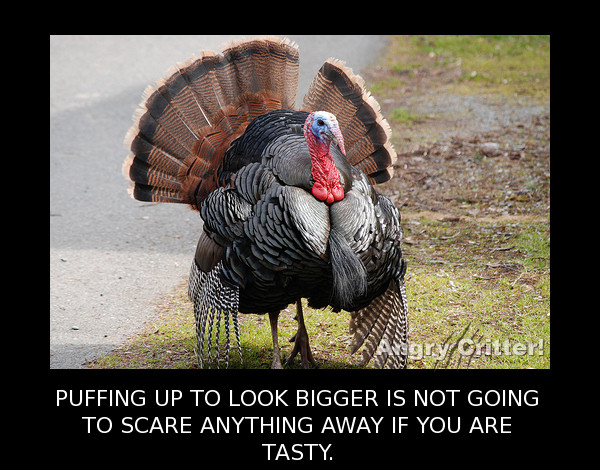My lovely Frys store (That would be Kroger to many of you regionally) sent me the monthly cooking booklet quasi magazine/marketing scheme. Typically the rag features healthy homecooked recipes with accompanying coupons for the store's own generic ingredients.
This time, the people responsible for the publication decided on a gluten free theme. While no one I regularly cook for needs a gluten free diet, countless families rely on gluten abstention to grant their digestive tract much needed TLC.
Shared for posterity; here is the takeaway from the Fry's Gluten Free Holiday brochure, to save your upcoming holiday cooking forays from themselves, and your gut from your cooking. First a few tips on some holiday staples, followed by actual recipes for a couple of holiday favorite dishes.
 |
| "And when it's dead... we can stuff even MORE food inside it when we cook it!" |
Follow the same precautions for cured hams or any alternative poultry like goose or duck.
~Gluten free rolls (or bread for stuffing.) You have the option of making gluten free bread from scratch, or purchasing some ready made products from the "healthy bread" section in your favorite health food store. If you've been living gluten free for long you probably already have some favorite bread brands picked out. Add tasty add ins to the baking process like herbs or cheese or drizzle melted butter and honey on the tops of loaves or rolls while baking to make them a little more "festive" for the occasion.
~Gluten Free chicken broth. As with your turkey, check labels on packaged product or make your own from your turkey drippings.
~Corn Starch is a great thickener for gravies, glazes and pie filling, boasting twice the thickening power of wheat flour. When using stir cold liquid into your corn starch until smooth, then add to your hot liquid.
 |
| Pumpkin Pie with gingerbread cookie crust. YUM! |
~Gluten Free cookies make a fantastic dessert on their own, or crumble and mix with butter for a deliciously simple pie crust. Make your pumpkin pie and eat it too!
Gluten Free Recipes
The magazine promises that these dishes are so good, no one will even notice the gluten is gone. I am inclined to believe it, they look amazing!
Sweet Potato Souffle
For Souffle:
6 sweet potatoes
3/4 C white sugar
1/2 C milk
1/2 C butter, melted
1 tsp vanilla extract
2 eggs, beaten
1 tsp cinnamon
1/2 tsp salt
For topping:
1 C brown sugar
1/3 C butter, melted
1 C pecans, roughly chopped.
Preheat the oven to 425. Wash sweet potatoes and prick all over with fork. Bake on baking sheet for 45 mins to one hour, or until fork easily pierces through the potatoes. Allow potatoes to cool; peel off skin.
Reduce heat to 350. Grease or butter one 2 qt. casserole dish. Manually or in a stand mixer mash the potatoes, blending until smooth. Add the sugar, milk, butter, vanilla, eggs, cinnamon and salt. Mix well. Pour the sweet potato mixture into the casserole dish.
To make the topping stir together the brown sugar butter and pecans into a bowl. Sprinkle topping over the the sweet potato mixture and bake for 40 minutes.
Gluten Free classic green bean casserole
For fried onions:
1 medium onion, sliced thin.
1/3 C gluten free flour/flour mix
1/4 tsp salt
1/4 C Vegetable oil
For casserole:
1 lb canned or fresh green beans, rinsed, trimmed and halved.2 tbsp unsalted butter
2 large portabella mushrooms, sliced
1/2 tsp black pepper
1/2 tsp garlic powder
1/3 C sour cream
2 tbsp gluten free flour
2 C gluten free cream of mushroom soup
Fried onion
Combine the sliced onions and dry ingredients in a large bowl, tossing until totally coated with flour and salt. Meanwhile heat the vegetable oil in a nonstick skillet on medium-high. Brown the onions in the hot oil, approx 3-4 minutes on each side. Place the browned onions on a paper towel lined baking sheet.
Preheat the oven to 400 for baking the casserole. If using fresh beans, boil in lightly salted water for 5 minutes, then rinse with cold water and set aside. If using canned beans rinse and set aside.
In a large saucepan melt the butter and toss in sliced mushrooms and pepper. Stir over medium heat for 5 mins, then add garlic and flour, stirring to coat.
Cook an additional minute, then add the sour cream and soup and lower the heat to medium low. Cook while the mixture thickens, approx 5 to 8 mins more.
Remove from heat and stir in half the fried onions and all of the drained beans. Pour mixture into large casserole dish and bake for 10 mins or until bubbly. Sprinkle remaining onions on top and bake for additional 5 mins. Serve warm.
Gluten Free Cornbread Stuffing
For cornbread:
1 C gluten free flour blend
1/4 C Sugar
4 tsp baking power
3/4 tsp salt
1 tsp xanthan gum
1/4 C shortening (not butter)
2 lg. eggs
1 C milk
1 C yellow cornmeal
For stuffing:
2 tbsp butter
1/2 C chopped celery
1 small chopped onion
2 eggs, beaten
2 C gluten free chicken stock
2 Tbsp dried sage
salt and pepper to taste
Preheat the oven to 425 F. Combine all the dry ingredients for the cornbread in a large bowl. Cut the shortening into the flour using either 2 forks, a pastry cutter, or a food processor until there are walnut sized pieces of shortening in a sandy flour.
Combine the eggs and milk in a small bowl. Make a well in the center of the dry ingredients and pour in the liquid. Stir with a rubber spatula until combined. Stir in the cornmeal, working quickly until just combined. Do not over stir. Pour into a greased 9x9x2 inch pan and bake for 20-25 minutes or until the sides of the cornbread shrink slightly away from the pan and a toothpick inserted in the center comes out clean.
Let cool, then crumble.
Reduce heat to 350 F. Grease one 9x13 inch baking dish. In a large skillet over medium heat melt butter and saute the onion and celery until soft.
In a large bowl combine the celery, onions, 3 C crumbled cornbread, eggs, chicken stock, sage salt and pepper. Mix well. Place into prepared dish and bake for 30 minutes. Refrigerate any leftovers. Serves 6-8
There you have it! I know I picked up a lot of ideas I plan to incorporate into my own gluten intensive feast.
Have a safe and happy Thanksgiving all!



























